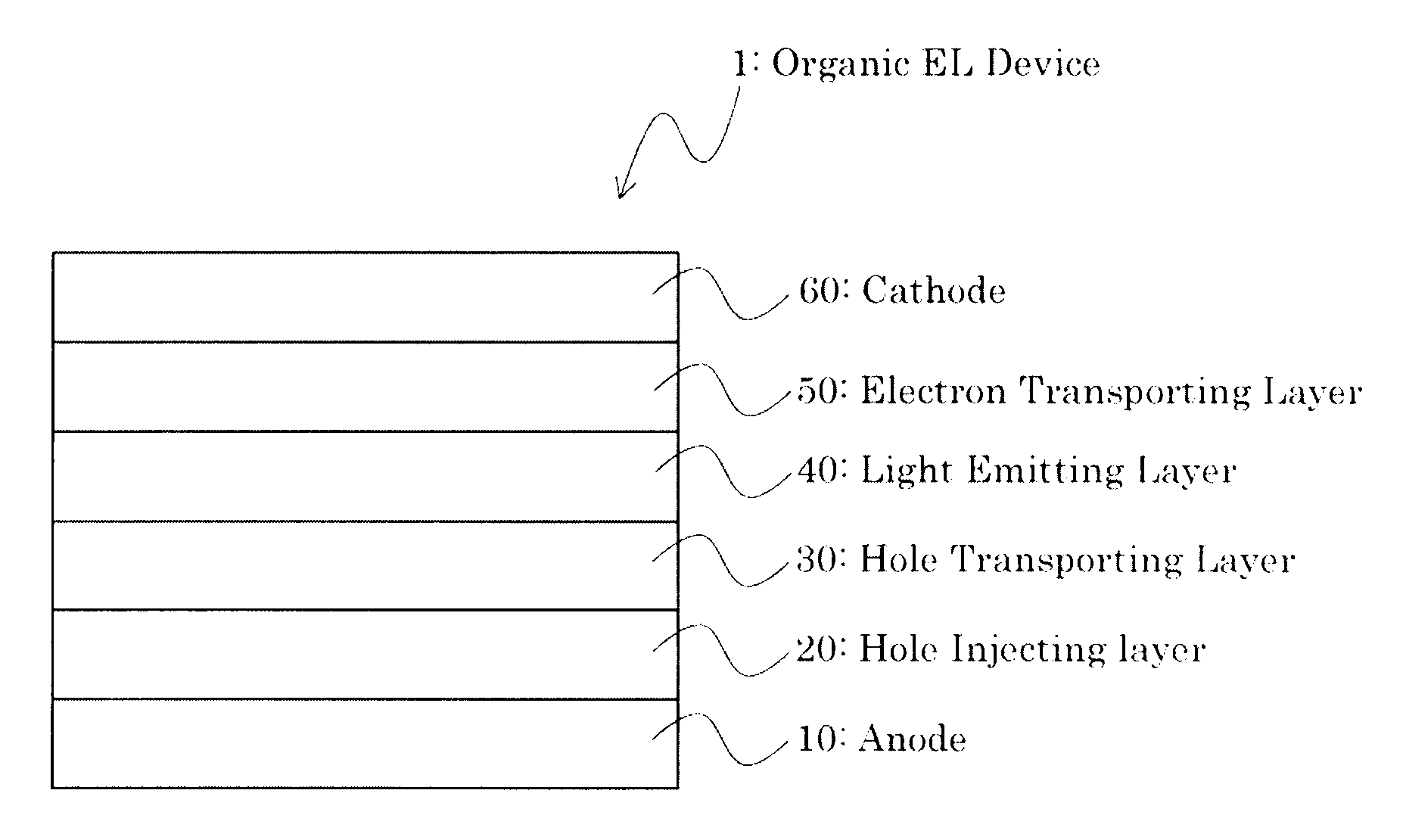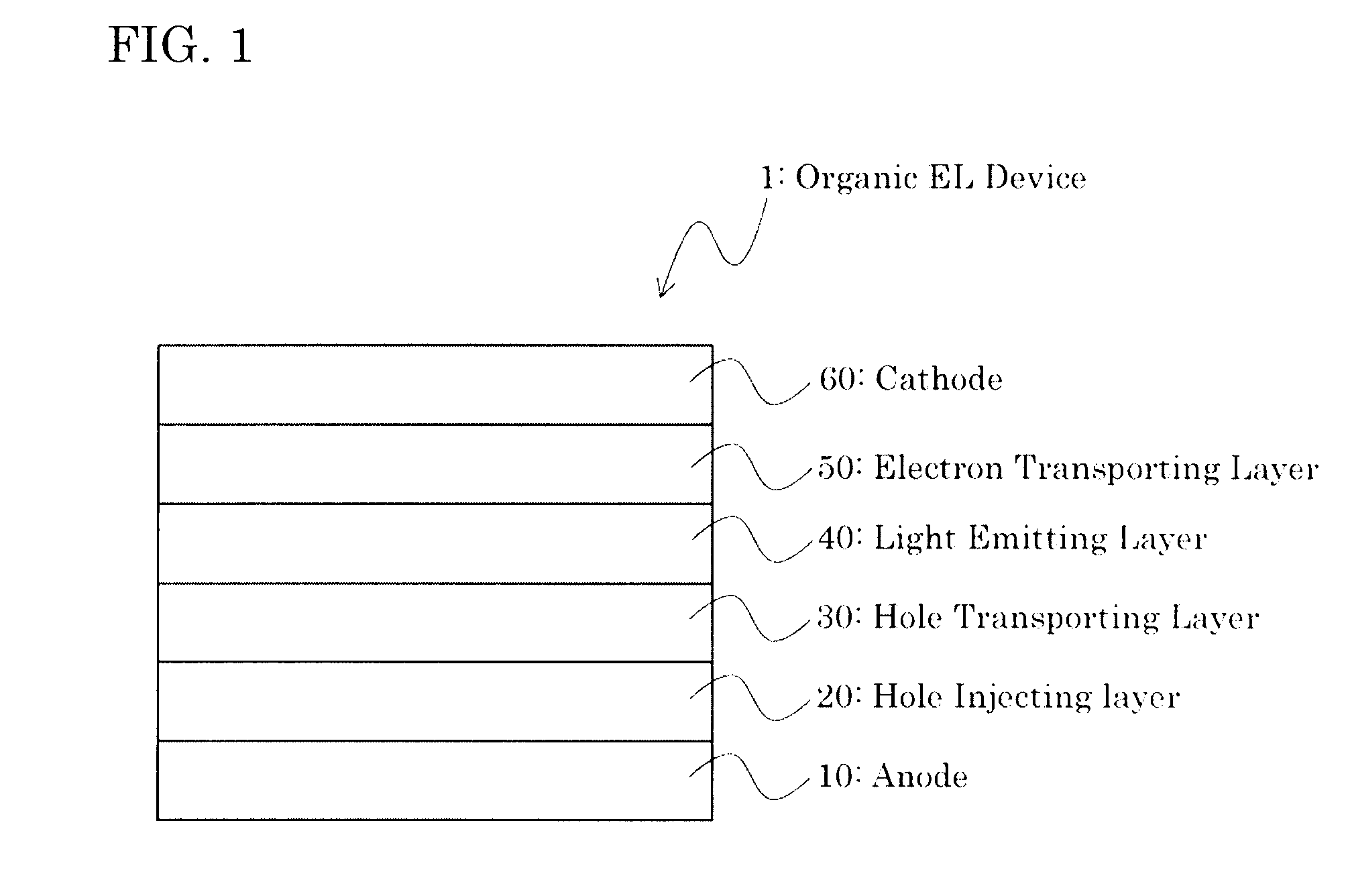Indenofluorenedione derivative, material for organic electroluminescent element, and organic electroluminescent element
a technology of indenofluorenedione and organic electroluminescent elements, which is applied in the direction of luminescent compositions, organic chemistry, thermoelectric devices, etc., can solve problems such as apparatus contamination, and achieve excellent heat resistance and long life
- Summary
- Abstract
- Description
- Claims
- Application Information
AI Technical Summary
Benefits of technology
Problems solved by technology
Method used
Image
Examples
example 1
Synthesis of Indenofluorenedione Derivative (A-1)
(1) Synthesis of Intermediate A
[0153]Intermediate A was synthesized according to the following synthesis scheme:
[0154]A mixture of 5.0 g of 1,5-diiodo-2,4-dimethylbenzene, 5.8 g of 4-bromophenylboronic acid, 0.65 g of tetrakis(triphenylphosphine)palladium(0), 44 ml of 2 M sodium carbonate, and 40 ml of toluene was refluxed under stirring in argon stream for 8 h. After cooling, the reaction product solution was filtered, washed with water and then methanol, and purified on a silica gel column (developer: methylene chloride), to obtain 4.5 g of white solids. Mass spectrometric measurement of the obtained white solids showed a peak at M / Z=416.
[0155]Next, a mixture of 4.5 g of the white solids obtained above, 13.0 g of potassium permanganate, 15 ml of pyridine, and 25 ml of water was heated under stirring at 100° C. for 8 h. After removing the solid matter by hot filtration, the filtrate was neutralized by adding a 1 N hydrochloric acid d...
example 2
Synthesis of Indenofluorenedione Derivative (A-2)
[0163]
[0164]In a flask, 2.0 g of the intermediate A synthesized in Example 1 was dissolved in 100 ml of methylene chloride under stirring. After replacing the inside of the flask with argon, the solution was cooled to −10° C. on a sodium chloride / ice cooling bath. To the solution, 2.7 g of titanium tetrachloride was added and then a mixed liquid of 8.2 g of bistrimethylsilylcarbodiimide and 40 ml of methylene chloride was added dropwise. After the dropwise addition, the solution was continuously cooled for 1 h, stirred for 4 h at room temperature, and then refluxed under stirring for 2 h. The precipitated reddish purple solids were collected by filtration and washed with methanol.
[0165]Through sublimation at 320° C., 1.2 g of the compound of the invention was obtained. Through IR measurement of the obtained compound, it was found that the absorption attributable to carbonyl group disappeared and the absorption attributable to cyano gr...
example 3
Synthesis of Indenofluorenedione Derivative (A-5)
[0167]
(1) Synthesis of Intermediate B
[0168]In the same manner as in the synthesis of intermediate A in Example 1 except for using 4.0 g of 3,5-bistrifluoromethylphenylboronic acid in place of 3.0 g of 4-trifluoromethylphenylboronic acid, 2.9 g of the intermediate B was obtained. The mass spectrometric measurement of the obtained solids showed a peak at M / Z=706.
(2) Synthesis of Indenofluorenedione Derivative (A-5)
[0169]In the same manner as in the synthesis of compound (A-1) in Example 1 except for changing 1.5 g intermediate A to 1.8 g of intermediate B, solids were obtained, which were purified by sublimation at 340° C., to obtain 1.5 g of dark purple crystals.
[0170]Through IR measurement of the obtained compound, it was found that the absorption attributable to carbonyl group disappeared and the absorption attributable to cyano group appeared at 2220 cm−1. Mass spectrometric measurement showed a peak at M / Z=802.
[0171]The reduction p...
PUM
| Property | Measurement | Unit |
|---|---|---|
| reduction potential | aaaaa | aaaaa |
| sublimation temperature | aaaaa | aaaaa |
| temperature | aaaaa | aaaaa |
Abstract
Description
Claims
Application Information
 Login to View More
Login to View More - R&D
- Intellectual Property
- Life Sciences
- Materials
- Tech Scout
- Unparalleled Data Quality
- Higher Quality Content
- 60% Fewer Hallucinations
Browse by: Latest US Patents, China's latest patents, Technical Efficacy Thesaurus, Application Domain, Technology Topic, Popular Technical Reports.
© 2025 PatSnap. All rights reserved.Legal|Privacy policy|Modern Slavery Act Transparency Statement|Sitemap|About US| Contact US: help@patsnap.com



